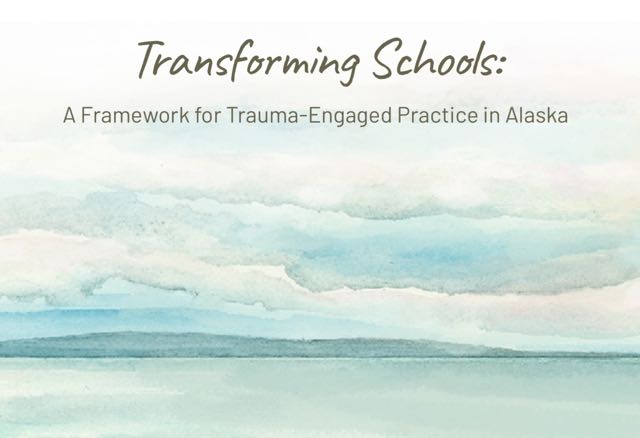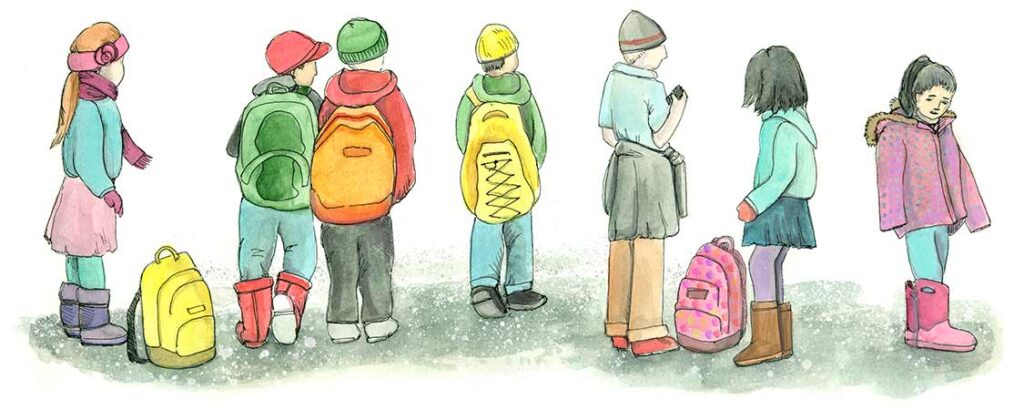Trauma-Engaged Services
What are Trauma-Engaged Schools?

Local wisdom, current research, and educational practice indicate that trauma is a significant barrier for students to come to school ready and able to learn. In response school boards and school districts, both nationally and across Alaska, have been changing the way they think about both learning and school environments to more fully support the needs of the whole student and to address trauma.
Promoting social and emotional health and creating culturally responsive trauma-informed learning environments can provide all children they need to achieve goals and their full potential. Below are Trauma-Engaged Schools resources and strategies as well as examples of work happening in Alaska.
Why do Trauma-Engaged school practices matter?
Schools, family and community members each have an important role to play and can work together to create a reliable space for children and create learning environments where each student can learn. What’s more, we know that when a school institute’s trauma-informed practices, it benefits all students.
While we may not always know which students have experienced trauma, we know that two out of three Alaskan children have been exposed to traumatic experiences. These experiences impact Alaskans across racial, social, economic, and geographic lines, and can lead to higher dropout rates, lower academic performance, lower employment rates and lower health outcomes.
The good news is that educators across Alaska are incorporating trauma-engaged approaches into schools and programs.
Alaska Resources that can help:
To support these efforts, school districts, Tribes, and community organizations can now access Alaska-specific resources
A Framework for Trauma-Engaged Practice: This framework provides insight into policies, practices, and shared understandings that can create a true shift in how school staff, students, and families work together to support student learning.
Trauma-Engaged Schools Toolkit: This online resource is a companion guide to the “Transforming Schools: A Framework for Trauma-Engaged Practice in Alaska,” released in 2019. The toolkit provides activities, tools and resources for each of the eleven components of the framework.
Trauma-Engaged Video Library: The Trauma-Engaged Schools Knowing to Doing Video Library offers over 50 peer-led and statewide experts’ short videos tied to the topics in the Framework. They are under 10 minutes and easily accessible for personal review or in a group setting to stimulate discussion.
“Trauma-informed practices are at the heart of increasing academic achievement for our students with the most vulnerable experiences. We have an opportunity to focus on strategies that enhance each child’s experience and we appreciate the efforts of AASB , the Department of Education and Early Development, and partners to provide a state wide frame for this critical work.” –Bridget Weiss, Juneau School District Superintendent

How do Trauma-Engaged Schools Promote Equity?
Educators have a legal and moral responsibility to provide equitable educational opportunities for all students regardless of their circumstances. The Department of Education says that “this hinges on access to a school environment equipped for safe and stimulating learning opportunities, resources for social and emotional growth, and excellent educators who are able to support students in getting and remaining on track to graduate from high school ready for college or careers.” *
With high rates of trauma in our schools and communities, if it is not addressed in our schools, it can become a barrier to students. Trauma-Engaged Schools practices and strategies use strengths already present in our students and families to encourage lifelong learning and success.
*Source: deiexperthub.org, adapted from The Department of Education
To find out more about how equity and Trauma-Engaged Schools:
- NEA workshop recording
To plan for more equitable outcomes for all students, use the Multi-Tiered Systems of Supports Planning Tool below:
“How do school boards create the CONDITIONS so that schools can create high trust/low-stress environments, rebuild the natural confidence of the most marginalized students, and improve their ability to turn inert facts into useable knowledge?” -Zaretta Hammond
How can AASB support Trauma-Engaged Schools in my district?

AASB offers a number of services to our members and school districts. To find out more about our services, reach out to Maressa Jensen.
Statewide professional development opportunities:
- Recorded webinars and professional development opportunities
- EED Modules
- Online Discussion Forum in partnership with the Teaching Channel and Alaska Staff Development Network
Coaching TES implementation
- SEL Champions also meet monthly in a professional learning community (PLC) via video conference that draws on the knowledge of the group.
Planning and visioning
- Working with boards to plan and prioritize TES strategies and approaches.
Data for School-Wide Trauma-Informed Approaches
- SCCS questions or tracking of progress (trauma questions, and SEL and self-care questions for staff)
To find out more about the services above, contact Maressa Jensen.

“Now that we have a common trauma-informed language, a conversation at lunch becomes a valuable brainstorming session. It has brought our staff closer together. We wanted trauma-informed practices to help us change the culture in our school. We’ve realized that the change starts with us.” – Alaska teacher
What does this work look like in your community?

Lower Yukon School District’s Pulasaraq Curriculum
Lower Yukon School District and AASB teamed up to develop and distribute the Pulasaraq, Yup’ik mental health and well-being curricula. A special thanks to the lead creation team, LYSD Yup’ik Curriculum Director Janet Johnson and retired teacher and contracted specialist Nita Rearden, for sharing this valuable social and emotional learning resource with our state.
Hoonah and Chatham Inservice
Commentary newsletter article: Trauma-Engaged Schools Inservice with Chatham & Hoonah
Anchorage School District
The Anchorage School District coordinated a day of learning with the community in November 2017 that focused on trauma-engaged and culturally sensitive practice. Marcus Wilson shares how the co-creation process was at the center of their success at Northstar Elementary.
Bering Strait School District
Bering Strait School District Staff Sarah Swanson spoke passionately about the work of co-creation of approaches in the district including curricula adaptations for culturally responsive social and emotional standards together.
Action Steps/Best Practices: What can I do to make schools more Trauma-Engaged?
All of the adults in a school community, Board members, Tribes, administrators, classified and teaching staff, Elders, have a crucial role in creating trauma-engaged learning environments that are safe and supportive. Professional learning helps each person confidently step into their role supporting students and build skills for putting trauma-engaged approaches into practice.
“Professional learning for trauma-engaged schools should focus not only on effective practice, but in cultivating a shared belief that together the school community can make a difference,” (p. 37).
To plan around the 11 sections- visit Toolkit Planning Section and Toolkit.
